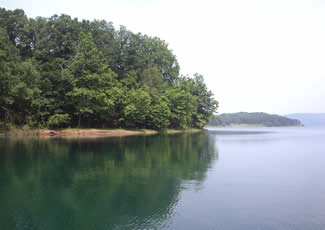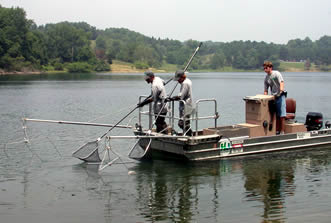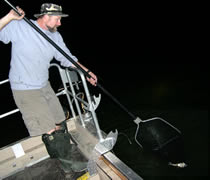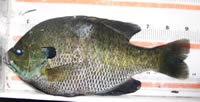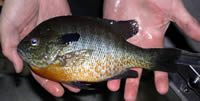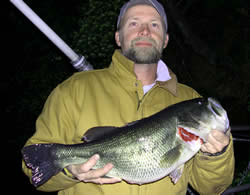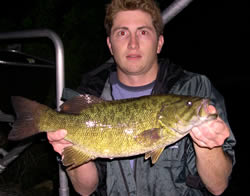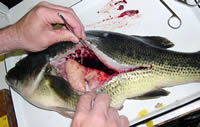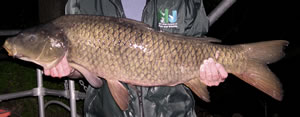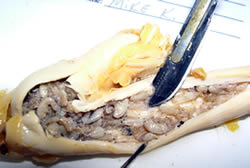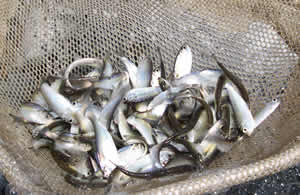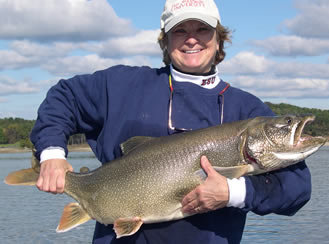|
Spotlight on Round Valley Reservoir
by Shawn Crouse
Senior Fisheries Biologist
June, 2007
East of the Border - Lake Trout Fishing In New Jersey - republicanherald.com, 5/25/14
Hearty Lake Trout Fishing Available at Merrill Creek and Round Valley Reservoirs - lehighvalleylive.com, 5/20/13
| Many
anglers dream of what lurks below the surface of their favorite
water body. Typically, our only link to the underwater world is
a thin strand of monofilament, but as fisheries biologists, we
have many other tools in our "tackle box" to help us
learn what swims beneath.
Staff
from the Bureau of
Freshwater Fisheries Research
and Management team recently spent three nights electrofishing
Round Valley Reservoir in Hunterdon County. This was conducted
as part of a Fisheries Inventory that will be used to assist
in the development of a Lake Management Plan, used to guide
fisheries management within this valuable and picturesque reservoir.
Also
known as "RVR" or "The Valley," this 2350-acre
water supply reservoir is extremely popular and important to
many anglers and boaters. Boats are launched from Fish and Wildlife's
main concrete boat ramp or the adjacent gravel launch.
|
|
These launches are free to licensed hunters and anglers (who must display
a photocopy of their license in the rear driver's side window). Other
users must obtain a Boat Ramp
Maintenance Permit, which can be purchased for $15.00 online at
https://nj.aspirafocus.com/internetsales/
or at any hunting/fishing license agent. Outboard motors are limited
to 9.9 horsepower (see Freshwater
Fishing Digest for more details). Both ramps are located off of
Round Valley Access Road, on Route 629, just north of the Division of
Parks and Forestry's Round
Valley Recreation Area. A third launch is available to those camping
within the recreation area.
|
|
Round
Valley Reservoir is managed as a Trophy Trout Lake, resulting
in more restrictive size and creel limits for trout. The general
trout regulations for brook, brown, and rainbow trout of a minimum
size of 7 inches, a daily limit of 4 or 6 fish (depending on
the season) and a closed pre-season do not apply at Round Valley.
Trophy Trout Lake regulations include a minimum size of 15 inches
and a daily limit of 2 fish, but there is no closed season for
these three species (see Freshwater
Fishing Digest).
The
lake trout regulations for Round Valley Reservoir also differ
from the general regulations: anglers can harvest a daily limit
of 1 fish at a minimum size of 20 inches, from January 1 through
September 15. There is a catch and release season, to protect
spawning lakers, starting September 16 through November 30.
The season then reopens on December 1.
|
Although
one of New Jersey's premier fishing hot spots, the conditions at RVR
could be better. A lack of nutrients to support plankton, coupled
by heavy predation by trout on the alewife population, may have resulted
in less than optimal trout growth in recent years. Data indicate the
lake trout population is out of balance. Observations by anglers,
now documented by fisheries biologists, indicate the following trends:
1)
Fewer large lake trout than in the past
2) Increased abundance of sub-legal fish
3) Severe decline in alewives (diminished forage for all salmonids),
and
4) Reduced nutrient content as indicated by increased water clarity
and other analyses, just to name a few.
Due
to a stockpiling effect of lake trout from 15 to 20 inches, a change
in the laker regulations has been proposed for the 2008 fishing season,
however it is not yet adopted because the public comment period has
not concluded. The proposed change will liberalize the harvest of
lake trout in an effort to balance the population structure and reduce
competition.
|
|
Specifically,
the proposed strategy is to reduce the number of what are currently
sub-legal fish. The proposed regulation would allow the harvest
of 3 lakers daily that are 15 to 20 in., a no harvest of fish
between 20 and 24 inches, and 1 laker of 24 in. or greater could
be kept. This potentially results in an angler bringing home
4 lakers for dinner. The increased harvest of lake trout (in
compliance with current fishing regulations of course) should
help minimize the previously stated problems. Stay tuned for
regulation updates.
With
all of that said, let's take a look at what we recently captured
in The Valley. Using a Smith-Root electrofishing boat we conducted
4 hours of electrofishing surveys around much of the reservoir's
perimeter. The surveys were conducted along the shoreline, at
night when fish commonly move in from their deeper water mid-day
refuge.
The
primary purpose of these surveys was to collect valuable data
concerning warmwater fish populations such as bass and sunfish.
Bass were collected for the full 4 hours, while panfish were
only collected for 1.5 hours. In total, over 820 fish of 19
species were collected.
|
|
|
The
most abundant species encountered was the bluegill, for which
data were collected from 204 fish. The
largest bluegill was 9.1 in. and weighed 0.6 lbs. (Photo # 4)
Other noteworthy panfish include 124 redbreast sunfish (with a
whopper at 9.7 in. and 0.7 lbs.) (Photo # 5) and 101 rock bass.
Other panfish, such as pumpkinseeds, black crappie, yellow perch
and white perch, were infrequently encountered. |
|
|
|
Bass were found in good quantities, with largemouth (174) edging
smallmouth (91) nearly 2 to 1, and were caught at rates of 44
and 23 per hour respectively.
The most impressive largemouth weighed 7.2 lbs. and measured
21.6 inches, while the nicest smallie weighed 3.4 lbs. and was
18.5 inches.
|
|
|
Twenty largemouth bass were retained for the purpose of testing
them for the presence of a fish disease that is new to the Northeastern
United States, Largemouth
Bass Virus. Various organs such as the kidneys, spleen and
swim bladder were collected and sent off for laboratory analysis.
Round Valley was selected as one of the lakes to be targeted
by the Division of Fish and Wildlife due to its popularity.
Heavy boat traffic, such as occurs at Round Valley, is one potential
means of disease dispersal. Results will be made available once
the studies are complete.
|
|
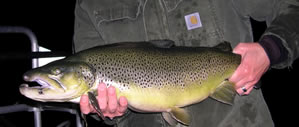 RVTA's recently stocked 9.7 lb. brown trout "money fish"
with jaw tag to prove it.>
RVTA's recently stocked 9.7 lb. brown trout "money fish"
with jaw tag to prove it.>
Click
to enlarge |
Although
not in search of trout, they showed up in numbers. Browns (55)
and rainbows (13) were also caught in the shallows, including
a 9.7 lb. 24.8 in. monster brown.
Round
Valley Trout Association's president Dennis Haggerty later
informed us the tag (as seen in the photo) indicated this was
a "money fish" the club had stocked just days before
the surveys were conducted. Don't worry, the fish was released
unharmed, along with many other nice browns and bows in the
20 in., 4 lb. class range.
|
A
few large American eels were encountered, the largest measuring 38
in. and weighing 4 lbs. 2 oz. This fish is closing in on the 42 in.,
6 lbs. 13 oz. state record that was caught in the Round Valley in
2005. That fish resides, as replicate mount, just a few hundred yards
across the street from the main boat launch at the Lebanon
Freshwater Fisheries Office.
|
The
longest fish collected outgrew the American eel by only 1 in.,
but certainly outweighed it - by more than 20 pounds! It was
a common carp weighing in at just under 25 lbs. Carp are known
for doing particularly well, in both abundance and size, in
nutrient rich waters.
Although
not an abundant species in The Valley, they do just fine in
cold, deep water bodies as well. Although carp make for fun
fishing, it is good that carp numbers are low in Round Valley
- they are detrimental to native fish and wildlife populations
by uprooting and destroying aquatic vegetation and negatively
impacting water quality.
|
|
What
is on the horizon for Round Valley Reservoir? Active management. This
complex ecological system has many forces of nature acting upon it at
any given time and many of them are concurrently being studied. In addition
to the lake inventory currently underway, recent efforts have been made
to learn more about the reservoir's productivity and carrying capacity
by studying nutrient and plankton levels. This work is being conducted
by Normandeau
Associates.
|
|
Dedicated
angling volunteers, led by Mike Kalinchock, collected 100 stomachs
from lake, brown and rainbow trout during 2006. The analysis
of their contents enables us to learn more about the diets of
the reservoir's salmonids. Only 4 of these stomachs contained
remnants of fish bones, indicating few alewives in the system.
The
dominant food source of lakers of all sizes are scuds or Gammarus.
One hundred thousand (100,000) alewives were stocked in June
in an attempt to reestablish a viable forage base which has
all but disappeared in recent years.
|
|
Lake
trout were aged by scientists from the Patrick
Center for Environmental Research at the Academy
of Natural Sciences in Philadelphia to determine growth
rates and if the population is stunted. When compared to other
populations in the Northeast and Ontario, initial results indicate
our lakers' growth is above average for young fish which feed
primarily on the abundant Gammarus found in the reservoir. However,
the growth of older fish appears much slower, likely due to
a diminished food supply.
|
|
|
|
Fishing
regulation changes are being proposed to realign the fishery in
order to strike a balance between predators and prey. Results
from the Largemouth Bass Virus testing are pending. More field
work is slated for this summer and fall, including shoreline seining
to assess reproductive success of warmwater species and to determine
the presence of various minnow species. Trapnetting and/or gillnetting
will supplement existing fisheries data, and the annual deepwater
gillnetting to collect lake trout will yield information on that
species.
The
Division of Fish and Wildlife, Round
Valley Trout Association, and many anglers are optimistic
that Round Valley Reservoir will continue to be one of the Garden
State's premiere fishing hotspots. All of the efforts being
put forth will hopefully ensure that quality fishing experiences
are commonplace at Round Valley Reservoir.
|
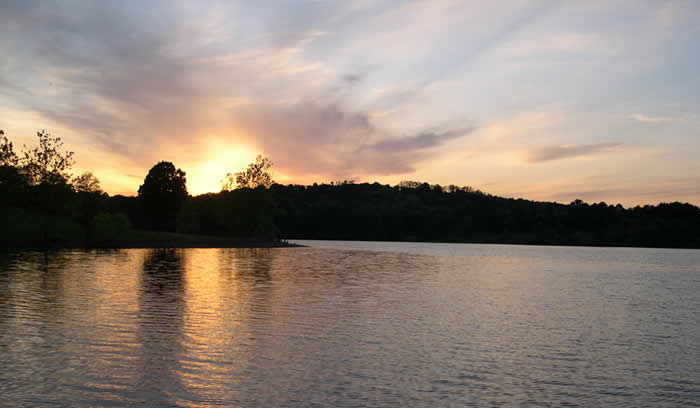 Time to start electrofishing on "The Valley."
Time to start electrofishing on "The Valley."
(For
more on Round Valley's lake trout, see Shawn's November, 2005 article,
Lunker Lakers Lurk Below.)
ADDITIONAL PAGES
|


